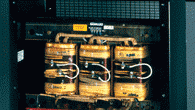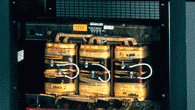Power quality in entertainment facilities

An ideal standard of power quality requires that a perfect sine wave of electrical current be delivered to electronic and other powered equipment. Theoretically, it is possible for an electrical distribution system to achieve that ideal; in reality, it can come close. Unfortunately, in many entertainment facilities the electrical distribution system falls far short of achieving perfect power quality.

The PowerSmith T-1000 zero sequence impedance transformer offers a practical solution to power quality issues.
The symptoms of poor power quality are well known – equipment spontaneously resets, signal transmission is poor, and background electrical noise is picked up by sensitive electronic equipment. As a result, quality and productivity suffer. Fortunately, there are simple and economical solutions that enable the electrical distribution system to meet a high standard of power quality, ensuring that all the digital electronic devices used in today’s studios, control rooms, Avid bays and related technical spaces are functioning at top efficiency.
Symptoms of poor power quality
If equipment resets without apparent reason, it may be due to momentary voltage sag of the power source. Proper operation of electronic equipment depends on constant voltage from the 120V source. Momentary voltage sag to 90V or 100V can cause the equipment to turn off and on. The root cause often can be traced to the high current draw of large motors or chillers operating off of the same transformer or feeder.
Harmonic distortion generated by the power supply often creates poor neutral-to-ground voltage reference, which can adversely affect signal transmission. Let’s say the electrical distribution system is delivering a pure sine wave, with 60Hz as the dominant or first harmonic order. However, each piece of digital equipment contains a switch mode power supply that converts AC to DC power. In the process, it attenuates the waveform, throwing third-order “waste” current back into the electrical system.
The effect is additive; eventually, third-order harmonics become the dominant order of the waveform. In turn, the neutral conductor becomes a current-carrying conductor, causing a voltage drop on that line. The result is poor signal transmission.
Get the TV Tech Newsletter
The professional video industry's #1 source for news, trends and product and tech information. Sign up below.
In many cases, zero sequence harmonic distortion can be traced to an undersized neutral conductor. In the past, the National Electrical Code (NEC) allowed downsizing of the neutral conductor because it was considered a non-current-carrying conductor in a three-phase shared neutral system. As discussed above, this is no longer the case in today’s entertainment facilities, in which the predominance of digital electronic equipment generates the harmonic distortion which carries the excessive harmonic currents.
Background electrical noise is caused by random voltage fluctuation with broadband spectrum content up to 200kHz. The induced electrical voltage in an interconnecting system is a product of the interaction of the variables of inductance, peak current noise or impulse, and rise time of the peak current. The resulting interference will distort most interconnect signal transmission.
Economical solutions
Fortunately, there are simple, economical solutions to these power quality issues. Proper space planning is fundamental to good power quality, and it starts with the identification of those portions of the facility that are operating critical loads vs. those operating chillers, pumps and so forth.
Isolating critical loads on separate transformers or feeders from those running chillers and motors will solve problems related to voltage drops and spontaneous equipment resets.
Effective branch circuit design is a basic, economical, yet effective approach to providing good power quality. Separating the branch circuits for computer loads and other equipment such as copier, printer, appliance and convenience outlets, is the industry standard for providing clean power. This means no more than four to six PCs on a 20A, 120V circuit; or a custom solution based on amperage of equipment.
The NEC requires that any grounding system, like this Lyncole XIT grounding system, tie back to the building ground system.
Locating panels and electrical distribution equipment closer to the load helps to reduce the effects of harmonic distortion. The shorter conductor runs to the source, often minimizing any neutral-to-ground voltage distortion.
An effective solution for low zero sequence harmonic distortion is the installation of a zero sequence filter in each panel serving highly nonlinear loads. This passive filter system traps third-order harmonics generated by AC to DC power conversions.
About five years ago, active zero sequence filters were introduced to stop harmonic distortion at the source by sampling the waveform of the electrical current, mathematically analyzing it, and injecting into the electrical distribution system the required frequencies to compensate for the distortion. However, if there is a flaw in the mathematical computations, this type of filter actually can introduce further harmonic distortion into the electrical distribution system. Until this technology is proven, the simpler (and less expensive) passive filter remains both a prudent and effective solution.
The grounding myth
The grounding myth often dominates discussions of background electrical noise. There are two parts to this myth. First, “an isolated ground system never ties back to the building ground system”; and the corollary, “the better the ground, 5V or less, and the more isolated it is from the main building ground, the better off our equipment will be.” Both parts are false.
First, the NEC requires that any grounding system tie back to the building ground system. As for the corollary, most entertainment facilities simply do not need sophisticated isolated ground power or other expensive grounding methods.
One of the simple methods to identify grounding issues is to measure neutral-to-ground bond at panels that serve the equipment and at load side. Continuity testing between equipment racks’ ground bonding is also recommended to ensure that the network racks are at the same ground reference.
Before designing a ground system, a site grounding test – either a soils analysis if it is a new site, or a grounding probe on an existing site – should be performed to identify the soil resistance. A value of 25V or below is considered a good ground reference for most entertainment facilities.
In an older facility, where a neutral ground conductor may have been downsized in the past, power quality often can be improved simply by replacing the old wire with a properly-sized neutral conductor. For technical grounding, a simple radial/star grounding is an effective, economical and code-compliant solution at almost all production facilities. All equipment racks with associated ground bus bars can be bonded with ground conductors, and the main connection back to the ground source located at the rack nearest to the building’s steel structure.
If a design space has equipment specifications requiring a 5V grounding point, and the site tests above 25V, grounding can be improved by applying ground rods, ground rings or even an electrolytic ground.
Another solution for mitigating electrical noise is utilizing the “60V Balance Power System.” This unique system allows the delivery of 120V of power at 60V to ground in lieu of 120V to ground as in conventional power systems. This system provides an “ungrounded floating neutral conductor,” which eliminates ground electrical noise, and its installation requires additional electrical components for safety protection.
At the far end of the spectrum, a facility with broadcast antenna will require a specialized grounding system. This typically involves a safety ground system and a site RF ground system. Both systems should be designed to deliver both lightning and RF grounding; the end result will be a unique solution for that facility.
Power quality is a crucial issue in the design and operation of entertainment facilities. Although the perfect wave may prove to be elusive, it is essential to design an electrical distribution system that meets the standard necessary to ensure that all the electronic devices used in daily activities, from shooting to post-production editing, are functioning at top efficiency.
T.K. Wong, P.E., is a senior associate with the Sports and Entertainment Market Focus Group at Syska Hennessy Group.
